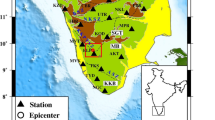Abstract
This paper analyzes bore-hole wall breakouts of the 5 wells located in southern part of the East China Sea region with logging sections deeper than 3 000 m and logging intervals longer than 1 000 m or even near 2 000 m. By making a combined study of the breakout characteristics of these 5 wells and 11 other wells analyzed in Xu and Wu (1997), it is inferred that the maximum horizontal principal compressive stress in the East China Sea region is generally in NE-SW direction, and the horizontal differential stress there is possibly weak. P- and T-axis orientations of focal mechanism of earthquakes occurred from 1977 to 1998 in the region of Okinawa trough and Ryukyu Islands are investigated. P-axes of earthquakes in Okinawa trough are generally oriented NE-SW, coinciding with the trough stretching trend, while T-axes are nearly perpendicular to the trend. This indicates that the horizontal action of the Philippine Sea Plate to the East China Sea region is not pushing but pulling. A two-dimensional finite element simulation is conducted to study the origin of the present-day tectonic stress in the East China Sea region. The result shows that the stress there is possibly attributable to both the strong northwestward compression in Taiwan region and the back-arc extension of the Ryukyu island arc. Less strong earthquakes in the East China Sea region is possibly related to the weak horizontal shear stress there.
Similar content being viewed by others
References
Artyushkov E V. 1983. Geodynamics. Amsterdam: Elsevier, 181
Bell J S, Gough D I. 1979. Northeast-southwest compressive stress in Alberta: evidence from oil wells. Earth Planet Sci Lett, 45: 475–482
Cornet F H, Burlet D. 1992. Stress field determinations in France by hydraulic tests in boreholes. J Geophys Res, 97(B8): 11829–11849
Gao A J, Xu Z H, Chen J G. 1990. Horizontal principal stress axes in Sichuan basin inferred from oil-well breakouts. Acta Seismologica Sinica, 4(2): 209–217
Huang Y R, Xu Z H, Gao A J, et al. 1994. A study on tectonic stress of Zhongyuan oil field with bore-hole breakouts data. Acta Seismologica Sinica, 7(2): 251–261
Xu Z H, Wang S Y, Huang Y R, et al. 1992. Tectonic stress field of China inferred from a large number of small earthquakes. J Geophys Res, 97(B7): 11876–11877
Xu Z H, Wang S Y, Yu Y X. 1993. Inversion of stress direction data by finite element analysis to obtain plate boundary forces. Acta Seismologica Sinica, 6(1): 111–122
Xu Z H, Wang S Y, Gao A J, et al. 1994. Redetermination of some early focal mechanism solutions of Chinese earthquakes. Seismological and Geomagnetic Observation and Research, 15(5): 1–9 (in Chinese)
Xu Z H, Wu S W. 1997. A study on present-day tectonic stress in the southern Yellow Sea and East China Sea region. Acta Geophysica Sinica, 40(6): 771–781 (in Chinese with English abstract)
Yu Y X, Xu Z H. 1994. A study on orientations of horizontal principal stress in Jizhong depression using bore-hole breakout data. Petroleum Exploration and Development, 21(2): 48–55 (in Chinese)
Zoback M D, Moos D, Mastin L. 1985. Well bore breakouts and in situ stress. J Geophys Res, 90(B7): 5523–5530
Zoback M L. 1992. First- and second-order pattern of stress in the lithosphere: the world stress map project. J Geophys Res, 97(B8): 11703–11728
Author information
Authors and Affiliations
Additional information
Contribution No. 99FE2015, Institute of Geophysics, China Seismological Bureau.
This paper is supported by the SSTCC Climb Project 95-S-05.
About this article
Cite this article
Xu, ZH., Xu, GQ. & Wu, SW. Present-day tectonic stress in the East China Sea region and its possible origin. Acta Seimol. Sin. 12, 542–549 (1999). https://doi.org/10.1007/s11589-999-0054-x
Received:
Revised:
Accepted:
Issue Date:
DOI: https://doi.org/10.1007/s11589-999-0054-x




